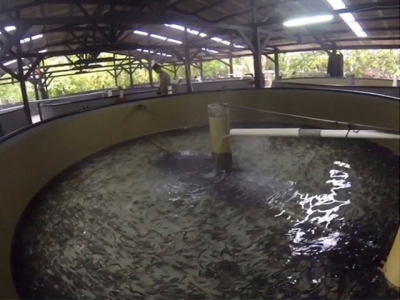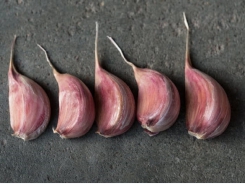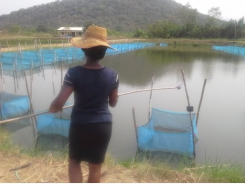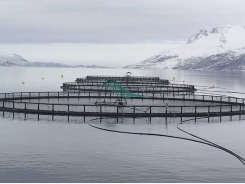Hyperthermia can boost innate immune system in juvenile fish - Part 1

A potential, unconventional approach to pathogen control in aquaculture
Barramundi (Asian sea bass) juveniles under heat shock treatment. fish in tank with hot water (55 degrees-C) flowing in the center.
Viral, bacterial and parasitic diseases remain the first constraint to aquaculture sustainability, with the industry’s annual losses globally reaching into the billions of dollars. Fighting the pathogens first requires their identification, but once a pathogen is known, finding the right preventive measures or treatments is a long process. There is still a broad gap between the scientific results and the actual needs of the farmers.
The toolbox of preventive measures is mainly based on the biosecurity concept, which is to avoid the introduction of pathogens into the culture systems by exclusion, sterilization, the use of specific pathogen free seedstock (SPF) and other measures. But the result is often naive fish juveniles that are not adjusted to the external environment.
The aquaculture industry has developed different products to enhance the health of cultured organisms through the use of probiotics and immunostimulants to help them support the pressure of the environment, including their culture systems. Vaccines have been progressively developed against some pathogens, but they are costly and take years before being licensed and available, and if viruses are mutating, they need continued adaptations. Other improvements have resulted from selective breeding programs developed for growth, but most programs are still developing disease resistance.
The various approaches to deal with disease often are confusing to many farmers; although some approaches are helpful to contain opportunistic pathogens, the most harmful ones are often successful in entering their culture systems. And the full biosecurity “kill everything” and the “pathogen-free” approaches can often reach their limits, which is demonstrated by the frequent resurgence of some known diseases in areas normally free of them, as well as the regular emergence of new pathogens.
A recent concept of looking at the pathogens in their whole environment, the pathobiome – representing the pathogenic agent integrated within its biotic environment – could shed new light for pathogen control.

After 10 minutes, all the juveniles have concentrated in the center of the tank, attracted to the hot water.
Learning with pathogens in the field
My experience with aquaculture pathogens is linked with my involvement in shrimp farming development in most of the tropical countries for more than 20 years. During this time, I directly confronted the emerging Yellow Head Virus (YHV) in Thailand, the White Spot Virus (WSSV) in Sri Lanka and the Infectious Hypodermal and Hematopoietic Necrosis Virus (IHHNV) in Mexico.
I was also involved for 16 years in an integrated Asian sea bass (barramundi) farm located in an optimal environment, including coral reef water without pollution, excellent and constant water temperature (29 degrees-C), salinity (~33 ppt) and dissolved oxygen at saturation, with significant water exchange and no other farm close by. The broodstock system, under a selective breeding program – together with the hatchery and nursery – were all located in a small island and the grow-out phase was based in large, open sea cages around it.
Yet this is an example of a fish farm located in starting in the best environment possible, but where several pathogens almost immediately affected the fish, killing about 90 percent of the juveniles, batch after batch. We implemented several measures, including complete UV treatment of the culture water, regular facility dry-out, use of immunostimulants and trials with antibiotics, none with a permanent positive effect and always experiencing a significant iridovirus outbreak after transferring the fish from the nursery to the grow-out cages.
We already knew some of the pathogens, but others were emerging. For many years, we fought the Viral Nervous Necrosis (VNN) – also known as viral encephalitis of fish – during the early larval stages, and also an emerging bacteria (causing the “big belly disease” when the fish were between 0.5 and 5 grams and an iridovirus from 5 to 80 grams. The bacterium Tenacibaculum maritimum was also present from the early juveniles to the pre-growing cages, and the bacterium Streptococcus iniae affected the fish from the nursery to adult size. The fish were also affected by the flatworm Benedenia, but only in the grow-out cages.
We were able to develop a Streptococcus vaccine through strong cooperation with a major commercial fish health company, and we also used different antibiotics and drugs in bath or in the feed, just like everybody else in our situation did. We found out that the only effective, long-term treatment to control T. maritimum in the nursery and Benedenia sp. in cages was peroxide baths.
But regardless of our efforts, the juvenile production remained erratic, with results worsening over time, and with increasing pathogen pressure as fish biomass was increased in the grow-out cages.
Related news
Tools

Phối trộn thức ăn chăn nuôi

Pha dung dịch thủy canh

Định mức cho tôm ăn

Phối trộn phân bón NPK

Xác định tỷ lệ tôm sống

Chuyển đổi đơn vị phân bón

Xác định công suất sục khí

Chuyển đổi đơn vị tôm

Tính diện tích nhà kính

Tính thể tích ao




 How technology can enhance Canadian salmon sector's sustainability
How technology can enhance Canadian salmon sector's sustainability  Tackling sea lice with Big Data
Tackling sea lice with Big Data